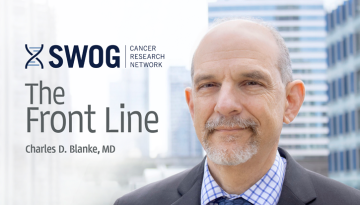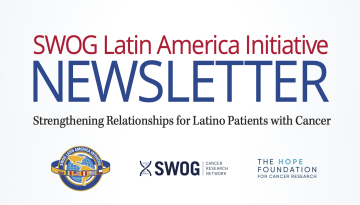Simple steps lengthen lives of high-risk AML patients
New research shows that quickly identifying patients with high-risk acute myeloid leukemia (AML), and speeding the process to find them a stem cell donor and performing the transplant earlier, can significantly improve their chances of surviving for at least two years after diagnosis without a relapse.
The research was conducted by SWOG, the cancer clinical trials group that is part of the National Cancer Institute's (NCI) National Clinical Trials Network, the oldest and largest cancer research network in the nation. Results will be presented Monday, Dec. 5 at the 58th American Society of Hematology Annual Meeting by Dr. John Pagel, chief of the Hematologic Malignancies program at the Swedish Cancer Institute in Seattle, WA and co-principal investigator for the SWOG research study, called S1203.
Pagel's presentation is one of 18 made by SWOG investigators at the 2016 ASH annual meeting, held in San Diego, CA.
"We are very excited to share these results," Pagel said. "This study showed we can get significantly more high-risk AML patients to a stem cell transplant before their cancer recurs by simply working hard to identify an appropriate donor and proceeding to transplantation as soon as possible. When we do, more high-risk patients live longer and are likely cured. This process may establish a new standard of care."
AML is a fast-growing type of cancer, common in the elderly, in which the bone marrow makes too many white blood cells. According to NCI statistics, there will be an estimated 19,950 new cases of AML in 2016, with an estimated 10,430 deaths, in the United States. Only 27 percent of AML patients survive five years after their diagnosis, NCI data shows. Some are at even greater risk. High-risk AML marked by certain genetic mutations is more resistant to chemotherapy, and even if it responds to chemotherapy, can more quickly cause relapse and death.
These high-risk patients are the population that Pagel and his team wanted to help when they designed and launched S1203. Previous research had shown that high-risk AML patients can live longer if they use a donor's stem cells to get an allogeneic hematopoietic cell transplant, or allogeneic HCT, after chemotherapy and before a relapse. But only about 40 percent of these high-risk patients do so. An allogeneic HCT is a complicated process of transplanting a type of stem cell from healthy donors, or in select cases, from cord blood, to patients with certain cancers of the bone marrow and blood.
Could Pagel and his team more quickly identify high-risk AML patients, and more quickly get them a transplant? If they did, how much of a difference would it make to their survival? These are the questions the SWOG team set out to answer.
To more rapidly identify high-risk patients, the SWOG team created a protocol that involved running a DNA test on patients immediately upon their AML diagnosis. The test checks for genetic mutations that signal high-risk - and likely extremely difficult to cure - variants of the disease, with results returning in about a week. Working with the National Marrow Donor Program (NMDP), they also created a process to rapidly identify stem cell donors for these high-risk patients. All patients in the trial got a cheek swab upon diagnosis, and DNA on the swab was used to find a donor in the worldwide registry, or investigators worked with relatives, such as siblings, to find a match even while the patient was undergoing chemotherapy. This coordinated, proactive approach is different. Often, doctors and patients wait until after chemotherapy, when the cancer returns, to begin to seek an allogeneic HCT.
Pagel and his team enrolled 738 eligible patients to the trial, and 159 of them - or about 22 percent - were identified as high-risk. Out of 159 high-risk patients, 107 had the stem cell transplant. The results were clear. Pagel and his team increased the transplant rate for high-risk patients from the 40 percent standard to a whopping 64 percent. And two-year survival for high-risk patients also increased significantly. Typically, only about 22 percent of high-risk patients survive two years after their cancer diagnosis. Pagel and his team saw that two-year survival rate increase to 45 percent for high-risk patients who got the transplant.
"The big message here is 'Don't delay identifying a donor,'" Pagel said. "Find these high-risk patients fast - and get them a transplant fast - and you can save lives. This only requires a simple, coordinated approach to testing and transplant searches. It's not complicated, but it makes an impact."
The co-principal investigator of the S1203 study team is Dr. Guillermo Garcia-Manero of University of Texas MD Anderson Cancer Center. The study team also includes: Megan Othus, Ph.D., of Fred Hutchinson Cancer Research Center; Dr. Min Fang of the University of Washington and the Seattle Cancer Care Alliance; Dr. Jerald Radich of the University of Washington and the Seattle Cancer Care Alliance; Dr. David A. Rizzieri of Duke University and the Duke Cancer Institute; Dr. Guido Marcucci of City of Hope; Dr. Stephen A. Strickland, Jr. of Vanderbilt University and Vanderbilt-Ingram Cancer Center; Dr. Mark. R. Litzow of Mayo Clinic; Dr. M. Lynn Savoie of University of Calgary and Arnie Charbonneau Cancer Institute; Dr. Stephen R. Spellman of the Center for International Blood & Marrow Transplant Research; Dr. Dennis L. Confer of the National Marrow Donor Program; Dr. Jeffrey W. Chell of the National Marrow Donor Program; Dr. Maria Brown of Rush University Medical Center; Dr. Bruno Medeiros of Stanford University Medical Center; Dr. Mikkael Sekeres of Cleveland Clinic; Dr. Tara Lin of the University of Kansas Cancer Center; Dr. Geoffrey Uy of Washington University School of Medicine in St. Louis; Dr. Bayard L. Powell of Wake Forest Baptist Health; Dr. Jonathan Kolitz of Norwell Health; Dr. Richard A. Larson of the University of Chicago; Dr. Richard M. Stone of Dana-Farber Cancer Institute; Dr. David Claxton of Penn State Cancer Institute; Dr. James Essell of Oncology Health Care; Dr. Selina Luger from Penn Medicine; Dr. Sanjay Mohan from Vanderbilt University and Vanderbilt-Ingram Cancer Center; Anna Moseley, M.S. of Fred Hutchinson Cancer Research Center; Dr. Harry Erba of University of Alabama at Birmingham School of Medicine; and Frederick R. Appelbaum of Fred Hutchinson Cancer Research Center.
S1203 was supported by the National Cancer Institute through grants CA180888; CA180819; CA18020; CA180821; CA180863; CA077202; and CCSRI 021039.
Other Recent Stories



